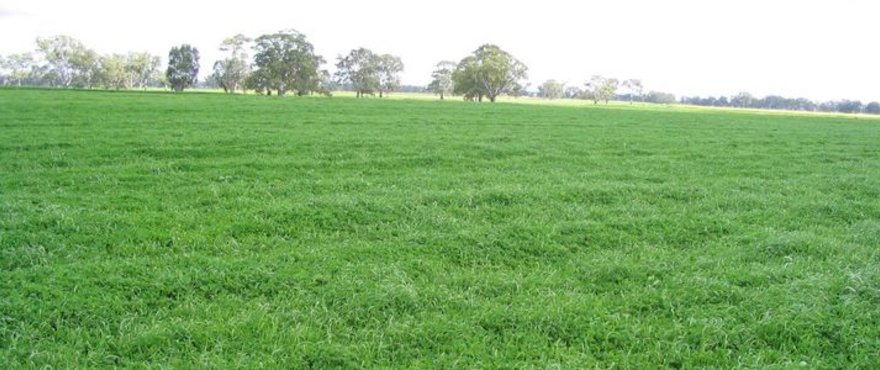Download a copy of the Scimitar spineless burr medic factsheet.
Scimitar (Medicago polymorpha) is a hybrid spineless burr medic developed as a superior replacement for Santiago. Scimitar is very productive on highly saline soils which are not subject to prolonged waterlogging. It also has a more erect growth habit, higher level of soft seed and increased herbage production relative to Santiago. Scimitar will provide increased herbage production and pest resistance for low to medium rainfall areas on a wide range of slightly acidic to alkaline soils. It will provide an effective disease break, while providing high quality feed for either hay or grazing purposes and is able to fix nitrogen, which is valuable for subsequent crop rotations.
Key features
- Early to mid season - approximately 90 days to flowering
- Erect growth habit with high herbage and seed production
- Maturity is 7 days later than Santiago
- Adaptable variety which grows on a wide range of soils
- High percentage of soft seed (24%) – Santiago (8.5%)
- Excellent ley farming option with dense regeneration
- Demonstrates excellent salt tolerance during key growing period compared to other species
- Better water logging tolerance than most medics
Key benefits
- High tolerance to saline soil conditions for a high-quality pasture option where other species may not grow
- Enables nitrogen fixation for improved pasture growth
- Produces high quality forage for livestock
- Good regeneration with both hard and soft seed levels
Pest Resistance
Scimitar has low resistance to blue-green aphid (Acyrthosiphon kondoi) but is susceptible to spotted alfalfa aphid (Therioaphis trifolii) and cowpea aphid (Aphis craccivora). Glasshouse trials have shown moderate resistance to root lesion nematode (Pratylenchus neglectus). Like most other medics, Scimitar is susceptible to red legged earth mites (Halotydens destructor), lucerne flea (Sminthurus virdis) and sitona weevil (Sitona discoidea).
Disease Resistance/Tolerance
Scimitar is generally free of foliar diseases but can be affected by black stem fungus (Phoma spp.) in undergrazed lush stands. Scimitar, like other medics, can suffer from Rhizoctonia (Rhizoctonia solani).
Agronomy and management
Scimitar is moderately hard seeded and produces approximately 24% soft seeds, compared to Santiago that has 8.5% soft seed. This will enable Scimitar to regenerate much better during the following year after seed set or after a cropping phase of up to two years compared to Santiago. The levels of hard seed in the soil will soften over a 5–10 year period, which is an extremely important characteristic of medic’s ability to survive over a long period of time in marginal rainfall districts. During establishment, defer grazing until plants are well established, lightly graze prior to flowering and then remove stock to allow seed set. Summer grazing needs to be managed carefully in the first year as overgrazing will reduce future regeneration. Once established, Scimitar persists well under rotational grazing ensuring good early ground cover but also promoting prostrate plant growth. Scimitar can be grazed in the first year of sowing, providing fresh feed in winter and spring and dry feed in the summer and autumn.
Plant Breeders Rights (PBR): This variety is registered under Plant Breeders Rights (PBR) in Australia. Unauthorised commercial propagation or any sale, conditioning, export, import or stocking of propagating material is an infringement under the Plant Breeders Rights Act (1994). Any breach of this legislation will leave the grower liable for prosecution.
Disclaimer: The information presented in this brochure is from official and other sources and is considered to be reliable. It is provided in good faith and every care has been taken to ensure its accuracy. Barenbrug does not accept any responsibility for the consequences that may arise from the acceptance of recommendations or the suggestions made.


